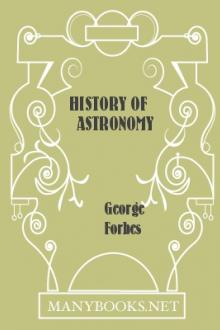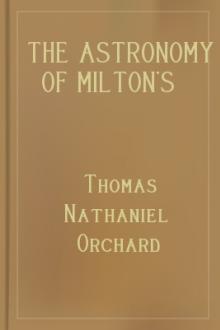History of Astronomy by George Forbes (classic children's novels TXT) 📕

- Author: George Forbes
- Performer: -
Book online «History of Astronomy by George Forbes (classic children's novels TXT) 📕». Author George Forbes
[Illustration: SOLAR ECLIPSE, 1882. From drawing by W. H. Wesley, Secretary R.A.S.; showing the prominences, the corona, and an unknown comet.]
On September 19th, 1868, eclipse spectroscopy began with the Indian eclipse, in which all observers found that the red prominences showed a bright line spectrum, indicating the presence of hydrogen and other gases. So bright was it that Jansen exclaimed: “Je verrai ces lignes-là en dehors des éclipses.” And the next day he observed the lines at the edge of the uneclipsed sun. Huggins had suggested this observation in February, 1868, his idea being to use prisms of such great dispersive power that the continuous spectrum reflected by our atmosphere should be greatly weakened, while a bright line would suffer no diminution by the high dispersion. On October 20th Lockyer,[10] having news of the eclipse, but not of Jansen’s observations the day after, was able to see these lines. This was a splendid performance, for it enabled the prominences to be observed, not only during eclipses, but every day. Moreover, the next year Huggins was able, by using a wide slit, to see the whole of a prominence and note its shape. Prominences are classified, according to their form, into “flame” and “cloud” prominences, the spectrum of the latter showing calcium, hydrogen, and helium; that of the former including a number of metals.
The D line of sodium is a double line, and in the same eclipse (1868) an orange line was noticed which was afterwards found to lie close to the two components of the D line. It did not correspond with any known terrestrial element, and the unknown element was called “helium.” It was not until 1895 that Sir William Ramsay found this element as a gas in the mineral cleavite.
The spectrum of the corona is partly continuous, indicating light reflected from the sun’s body. But it also shows a green line corresponding with no known terrestrial element, and the name “coronium” has been given to the substance causing it.
A vast number of facts have been added to our knowledge about the sun by photography and the spectroscope. Speculations and hypotheses in plenty have been offered, but it may be long before we have a complete theory evolved to explain all the phenomena of the storm-swept metallic atmosphere of the sun.
The proceedings of scientific societies teem with such facts and “working hypotheses,” and the best of them have been collected by Miss Clerke in her History of Astronomy during the Nineteenth Century. As to established facts, we learn from the spectroscopic researches (1) that the continuous spectrum is derived from the photosphere or solar gaseous material compressed almost to liquid consistency; (2) that the reversing layer surrounds it and gives rise to black lines in the spectrum; that the chromosphere surrounds this, is composed mainly of hydrogen, and is the cause of the red prominences in eclipses; and that the gaseous corona surrounds all of these, and extends to vast distances outside the sun’s visible surface.
FOOTNOTES:
[1] Rosa Ursina, by C. Scheiner, fol.; Bracciani, 1630.
[2] R. S. Phil. Trans., 1774.
[3] Ibid, 1783.
[4] Observations on the Spots on the Sun, etc., 4°; London and Edinburgh, 1863.
[5] Periodicität der Sonnenflecken. Astron. Nach. XXI., 1844, P. 234.
[6] R.S. Phil. Trans. (ser. A), 1906, p. 69-100.
[7] “Researches on Solar Physics,” by De la Rue, Stewart and Loewy; R. S. Phil. Trans., 1869, 1870.
[8] “The Sun as Photographed on the K line”; Knowledge, London, 1903, p. 229.
[9] R. S. Proc., xv., 1867, p. 256.
[10] Acad. des Sc., Paris; C. R., lxvii., 1868, p. 121.
13. THE MOON AND PLANETS.
The Moon.—Telescopic discoveries about the moon commence with Galileo’s discovery that her surface has mountains and valleys, like the earth. He also found that, while she always turns the same face to us, there is periodically a slight twist to let us see a little round the eastern or western edge. This was called libration, and the explanation was clear when it was understood that in showing always the same face to us she makes one revolution a month on her axis uniformly, and that her revolution round the earth is not uniform.
Galileo said that the mountains on the moon showed greater differences of level than those on the earth. Shröter supported this opinion. W. Herschel opposed it. But Beer and Mädler measured the heights of lunar mountains by their shadows, and found four of them over 20,000 feet above the surrounding plains.
Langrenus [1] was the first to do serious work on selenography, and named the lunar features after eminent men. Riccioli also made lunar charts. In 1692 Cassini made a chart of the full moon. Since then we have the charts of Schröter, Beer and Mädler (1837), and of Schmidt, of Athens (1878); and, above all, the photographic atlas by Loewy and Puiseux.
The details of the moon’s surface require for their discussion a whole book, like that of Neison or the one by Nasmyth and Carpenter. Here a few words must suffice. Mountain ranges like our Andes or Himalayas are rare. Instead of that, we see an immense number of circular cavities, with rugged edges and flat interior, often with a cone in the centre, reminding one of instantaneous photographs of the splash of a drop of water falling into a pool. Many of these are fifty or sixty miles across, some more. They are generally spoken of as resembling craters of volcanoes, active or extinct, on the earth. But some of those who have most fully studied the shapes of craters deny altogether their resemblance to the circular objects on the moon. These so-called craters, in many parts, are seen to be closely grouped, especially in the snow-white parts of the moon. But there are great smooth dark spaces, like the clear black ice on a pond, more free from craters, to which the equally inappropriate name of seas has been given. The most conspicuous crater, Tycho, is near the south pole. At full moon there are seen to radiate from Tycho numerous streaks of light, or “rays,” cutting through all the mountain formations, and extending over fully half the lunar disc, like the star-shaped cracks made on a sheet of ice by a blow. Similar cracks radiate from other large craters. It must be mentioned that these white rays are well seen only in full light of the sun at full moon, just as the white snow in the crevasses of a glacier is seen bright from a distance only when the sun is high, and disappears at sunset. Then there are deep, narrow, crooked “rills” which may have been water-courses; also “clefts” about half a mile wide, and often hundreds of miles long, like deep cracks in the surface going straight through mountain and valley.
The moon shares with the sun the advantage of being a good subject for photography, though the planets are not. This is owing to her larger apparent size, and the abundance of illumination. The consequence is that the finest details of the moon, as seen in the largest telescope in the world, may be reproduced at a cost within the reach of all.
No certain changes have ever been observed; but several suspicions have been expressed, especially as to the small crater Linné, in the Mare Serenitatis. It is now generally agreed that no certainty can be expected from drawings, and that for real evidence we must await the verdict of photography.
No trace of water or of an atmosphere has been found on the moon. It is possible that the temperature is too low. In any case, no displacement of a star by atmospheric refraction at occultation has been surely recorded. The moon seems to be dead.
The distance of the moon from the earth is just now the subject of re-measurement. The base line is from Greenwich to Cape of Good Hope, and the new feature introduced is the selection of a definite point on a crater (Mösting A), instead of the moon’s edge, as the point whose distance is to be measured.
The Inferior Planets.—When the telescope was invented, the phases of Venus attracted much attention; but the brightness of this planet, and her proximity to the sun, as with Mercury also, seemed to be a bar to the discovery of markings by which the axis and period of rotation could be fixed. Cassini gave the rotation as twenty-three hours, by observing a bright spot on her surface. Shröter made it 23h. 21m. 19s. This value was supported by others. In 1890 Schiaparelli[2] announced that Venus rotates, like our moon, once in one of her revolutions, and always directs the same face to the sun. This property has also been ascribed to Mercury; but in neither case has the evidence been generally accepted. Twenty-four hours is probably about the period of rotation for each of these planets.
Several observers have claimed to have seen a planet within the orbit of Mercury, either in transit over the sun’s surface or during an eclipse. It has even been named Vulcan. These announcements would have received little attention but for the fact that the motion of Mercury has irregularities which have not been accounted for by known planets; and Le Verrier[3] has stated that an intra-Mercurial planet or ring of asteroids would account for the unexplained part of the motion of the line of apses of Mercury’s orbit amounting to 38” per century.
Mars.—The first study of the appearance of Mars by Miraldi led him to believe that there were changes proceeding in the two white caps which are seen at the planet’s poles. W. Herschel attributed these caps to ice and snow, and the dates of his observations indicated a melting of these ice-caps in the Martian summer.
Schroter attributed the other markings on Mars to drifting clouds. But Beer and Mädler, in 1830-39, identified the same dark spots as being always in the same place, though sometimes blurred by mist in the local winter. A spot sketched by Huyghens in 1672, one frequently seen by W. Herschel in 1783, another by Arago in 1813, and nearly all the markings recorded by Beer and Mädler in 1830, were seen and drawn by F. Kaiser in Leyden during seventeen nights of the opposition of 1862 (_Ast. Nacht._, No. 1,468), whence he deduced the period of rotation to be 24h. 37m. 22s.,62—or one-tenth of a second less than the period deduced by R. A. Proctor from a drawing by Hooke in 1666.
It must be noted that, if the periods of rotation both of Mercury and Venus be about twenty-four hours, as seems probable, all the four planets nearest to the sun rotate in the same period, while the great planets rotate in about ten hours (Uranus and Neptune being still indeterminate).
The general surface of Mars is a deep yellow; but there are dark grey or greenish patches. Sir John Herschel was the first to attribute the ruddy colour of Mars to its soil rather than to its atmosphere.
The observations of that keen-sighted observer Dawes led to the first good map of Mars, in 1869. In the 1877 opposition Schiaparelli revived interest in the planet by the discovery of canals, uniformly about sixty miles wide, running generally on great circles, some of them being three or four thousand miles long. During the opposition of 1881-2 the same observer re-observed the canals, and in twenty of





Comments (0)